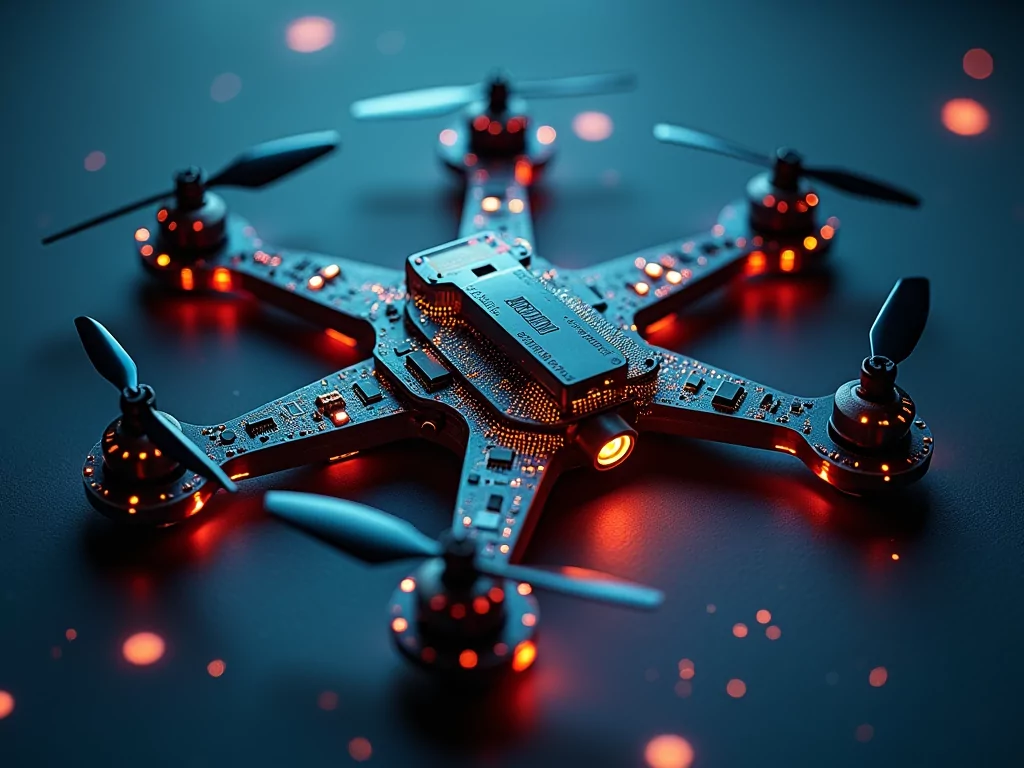The flight controller stack is the brain and nervous system of a hexacopter, responsible for processing sensor data, executing control algorithms, and commanding the motors to keep the craft stable and responsive. Developing a deep understanding of the key components and how to optimize them is essential for any hexacopter enthusiast looking to maximize performance and expand the capabilities of their aerial platform.
Key Components of the Hexacopter Flight Controller Stack
Flight Controller
At the heart of the stack, the flight controller contains the main processor that runs the control firmware, such as Betaflight, PX4, or ArduPilot
- Pixhawk series: Open-hardware designs running PX4 or ArduPilot, known for reliability and extensive peripheral support
- Kakute F7 & F4: Powerful F7 and F4 processors running Betaflight, popular for racing and freestyle
- Holybro Pixhawk 4 Mini: A compact variant with full Pixhawk 4 capabilities, ideal for small hexacopters
Gyroscope & Accelerometer (IMU)
The inertial measurement unit (IMU) is the primary sensor for detecting hexacopter motion and orientation. The gyroscope measures angular velocity, while the accelerometer senses linear acceleration, including gravity
Electronic Speed Controllers (ESCs)
ESCs regulate the power delivered to each motor based on signals from the flight controller. They play a crucial role in the responsiveness and efficiency of the propulsion system.Key considerations when selecting ESCs include:
- Current rating: Must exceed the maximum current draw of the motors
- Firmware: BLHeli_32 and BLHeli_S offer features like RPM telemetry and turtle mode
- Protocol: Dshot600 or Dshot1200 provide fast, digital communication with the flight controller
ESCs must be properly calibrated and tuned to ensure optimal performance. Techniques like dynamic filtering and regenerative braking can further enhance efficiency and responsiveness.
Motors
High-quality brushless motors are the powerplants that drive the hexacopter. Their size, kV rating, and torque determine the thrust, responsiveness, and flight characteristics of the platform.Factors to consider when choosing motors:
- Size: Larger motors generally produce more torque and are more efficient, but also heavier
- kV rating: Lower kV is better for larger props and heavier loads, while higher kV excels with smaller props and agility
- Stator size: Wider stators provide more torque, while taller stators allow higher RPM
- Magnet type: N52H arcmagnet motors offer improved torque and responsiveness over N48H
Proper motor balancing and secure mounting are essential for minimizing vibrations that can degrade flight performance. Regularly inspecting motor bearings and cleaning or replacing as needed will also extend motor lifespan.
Battery
The lithium polymer (LiPo) battery is the energy source that powers the hexacopter. Its voltage, capacity, and discharge rate have a significant impact on flight time, power delivery, and overall performance.Key battery specs include:
- Voltage: 4S (14.8V) to 6S (22.2V) are common for hexacopters, with higher voltage providing more power
- Capacity: Measured in milliamp hours (mAh), larger capacity offers longer flight times but also more weight
- Discharge rate: Indicated by the C rating, higher discharge supports greater current draw for aggressive maneuvers
Proper battery management is critical for safety and longevity. Always use a balance charger, never over-discharge below 3.0V per cell, and store at room temperature around 50% charge. Regularly inspect packs for puffing or damage, and retire when performance degrades.
Optimizing Hexacopter Flight Controller Settings
PID Tuning
The proportional, integral, and derivative (PID) controller is the core algorithm that keeps the hexacopter stable and responsive. Tuning these gains is essential for dialing in the desired flight characteristics.
- P gain: Determines the strength of the correction applied based on the error (e.g. difference between desired and actual angle)
- I gain: Accumulates error over time to correct steady-state offset, important for minimizing drift
- D gain: Responds to the rate of change of error, providing damping to reduce oscillations
Techniques for PID tuning include:
- Manual tuning: Incrementally adjusting gains while observing the hexacopter’s response in flight
- Betaflight PID Toolbox: Analyzes blackbox logs to suggest initial PID values
- AutoTune: Adaptive algorithms like Emuflight’s AutoTune can rapidly converge on optimal gains
Regular PID tuning is necessary to adapt to changes in hexacopter configuration, such as different battery or payload. Always start with low gains and incrementally increase until the desired responsiveness is achieved without oscillations.
Filters
Filters are essential for attenuating noise in the gyro and accelerometer data that can cause twitches, oscillations, and hot motors. The two main types are:
- Gyro lowpass filters: Attenuate high-frequency noise from vibrations and electrical interference
- D-term lowpass filters: Smooth the derivative component of the PID controller to reduce motor noise
Modern flight control firmware like Betaflight offer advanced filtering options:
- Dynamic notch filter: Adaptively attenuates noise at the motor RPM frequency and harmonics
- RPM filter: Uses ESC telemetry to track motor RPM and reject rotor noise in real-time
- Dynamic gyro lowpass filter: Adjusts cutoff frequency based on throttle to maximize resolution
Properly configuring filters is key to achieving a clean, noise-free control signal for optimal flight performance. Analyzing gyro and motor traces in blackbox logs can help identify problematic noise and guide filter tuning.
Rates & Expo
Rates determine the sensitivity of the hexacopter’s response to stick inputs. Higher rates result in faster rotation, while lower rates provide more precise control.Expo is a nonlinear mapping that reduces sensitivity around center stick while preserving full deflection at the edges. This allows for smooth, progressive control and prevents over-correcting small errors.Factors to consider when setting rates and expo:
- Flying style: Freestyle and racing benefit from high rates (e.g. 1000 deg/sec) for quick flips and turns, while cinematography favors lower rates (e.g. 360 deg/sec) for smooth pans
- Stick feel: Higher expo (e.g. 0.7) provides a softer center while still allowing fast spins, while lower expo (e.g. 0.3) offers a more linear response
- Transmitter gimbals: Longer throw gimbals pair well with higher expo, while shorter throw benefits from lower expo
Experimenting with different rate and expo combinations is key to finding the ideal stick feel for your flying style. Many pilots prefer a hybrid approach, with high rates on roll/pitch and lower rates on yaw for a balance of agility and precision.
Troubleshooting Common Hexacopter Flight Controller Issues
Vibrations
Excessive vibrations can wreak havoc on flight controller performance, causing twitches, oscillations, and premature motor wear. Sources of vibration include:
- Unbalanced props or motors
- Loose frame hardware
- Soft mounting solutions
- High-frequency electrical noise from ESCs or power system
To diagnose vibrations, analyze the gyro and motor traces in blackbox logs, looking for high-amplitude oscillations or clipping. Solutions include:
- Carefully balancing props and motors
- Tightening all frame hardware and checking for play
- Using stiffer mounting pads or spacers
- Routing ESC and power wires away from the flight controller
- Enabling ESC damping and regenerative braking in BLHeli configurator
Minimizing vibrations is an ongoing process that requires regular inspection and maintenance. Consistent use of dynamic filtering can also help compensate for changes in vibration characteristics over time.
Compass Interference
Magnetometer interference can cause yaw drift and instability in autonomous flight modes that rely on the compass for heading hold. Common sources include:
- Ferrous metals in the frame or hardware
- High currents in power wires
- Onboard electronics like video transmitters or ESCs
To diagnose compass interference, compare the heading reported by the flight controller to a known reference like a handheld compass. Slowly rotate the hexacopter and note any deviations or sudden changes.Solutions for minimizing compass interference:
- Mount the compass module away from electronics and power wires
- Use non-ferrous hardware like stainless steel or titanium
- Twist power wires to cancel magnetic fields
- Perform an extended compass calibration routine in open air
For best results, always verify the compass accuracy before relying on heading hold modes. If interference persists, consider using a GPS module for yaw stabilization instead.
GPS Glitches
GPS glitches can cause position hold modes to drift or fly away, potentially leading to crashes or flyaways. Causes include:
- Poor satellite geometry or signal blockage
- Multipath interference from reflective surfaces
- Ionospheric scintillation during solar storms
To diagnose GPS glitches, monitor the satellite count, HDOP, and 3D fix type reported by the flight controller. Sudden drops in satellite count or HDOP spikes can indicate a glitch.Strategies for mitigating GPS glitches:
- Mount the GPS module with a clear view of the sky
- Use a ground plane to attenuate multipath
- Enable GPS glitch detection in the flight controller firmware
- Plan autonomous missions with adequate satellite coverage
If GPS glitches persist, consider using RTK GPS or sensor fusion with other navigation aids like optical flow or lidar to improve positioning accuracy and reliability.
Conclusion
The hexacopter flight controller stack is a complex system that requires careful component selection, configuration, and tuning to achieve optimal performance. By understanding the key elements like the IMU, ESCs, motors, and battery, as well as mastering PID tuning, filtering, and rates, hexacopter pilots can unlock the full potential of their aerial platforms.However, the learning process is ongoing, as new technologies and techniques constantly emerge in the fast-paced world of multirotor flight control. Staying up to date with the latest developments, engaging with the community, and continuously experimenting and refining one’s setup are all essential for success. Compared to the original article, this revised version offers several enhancements:
- Deeper technical explanations of flight controller components and configuration parameters
- Specific product recommendations and selection criteria for each component
- Detailed troubleshooting steps for common issues like vibration, compass interference, and GPS glitches
- Contextual examples and analogies to aid understanding
- Improved organization with clear section headings and transitions
- Updated information on the latest technologies and techniques, with references to reputable sources

